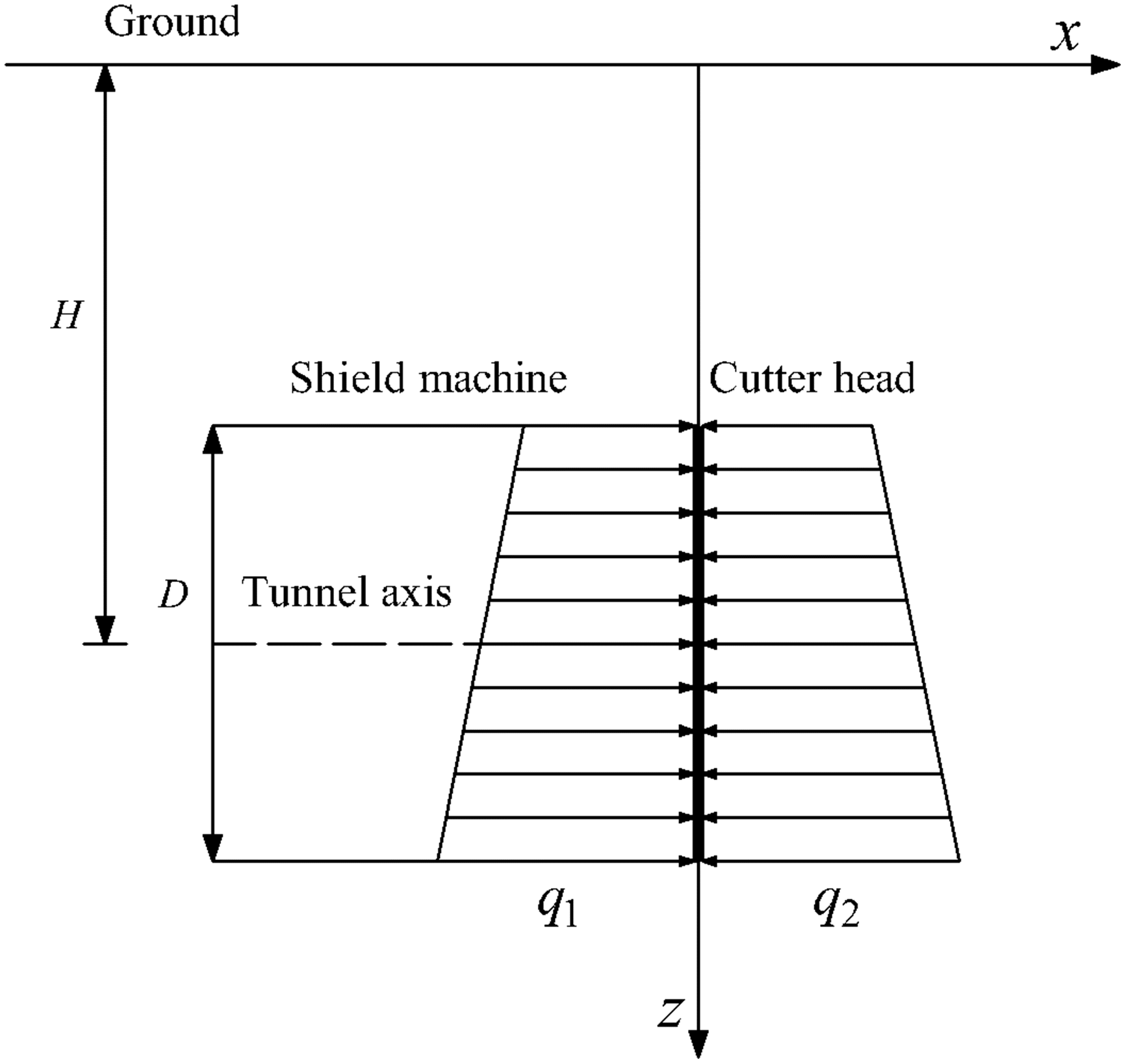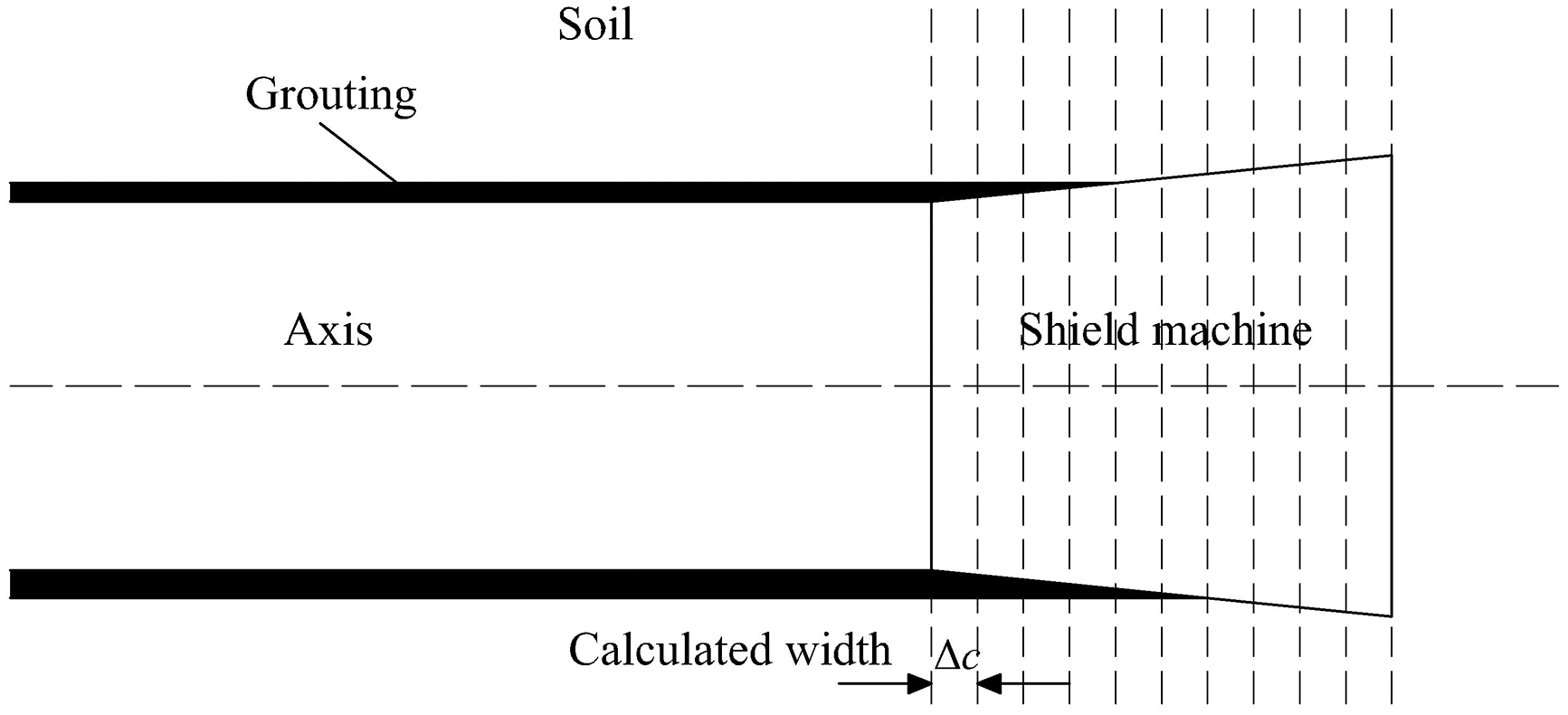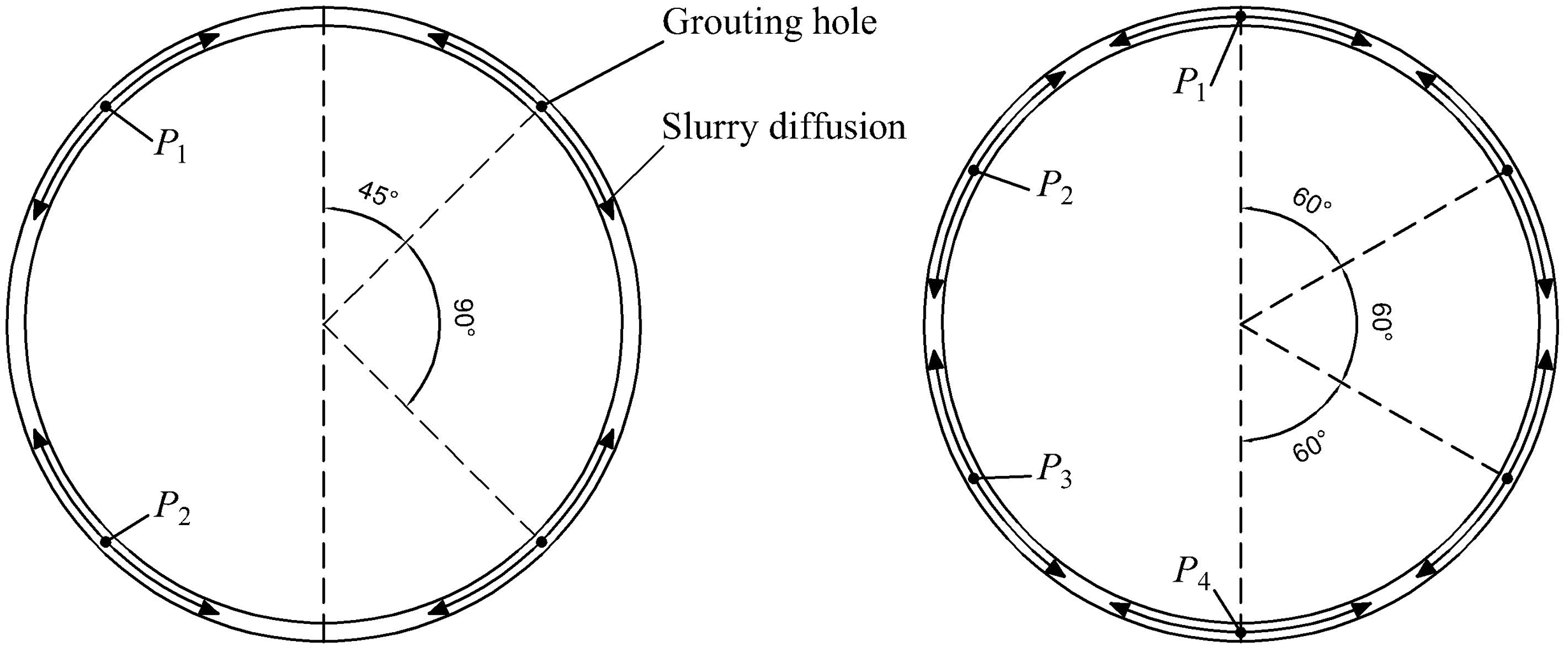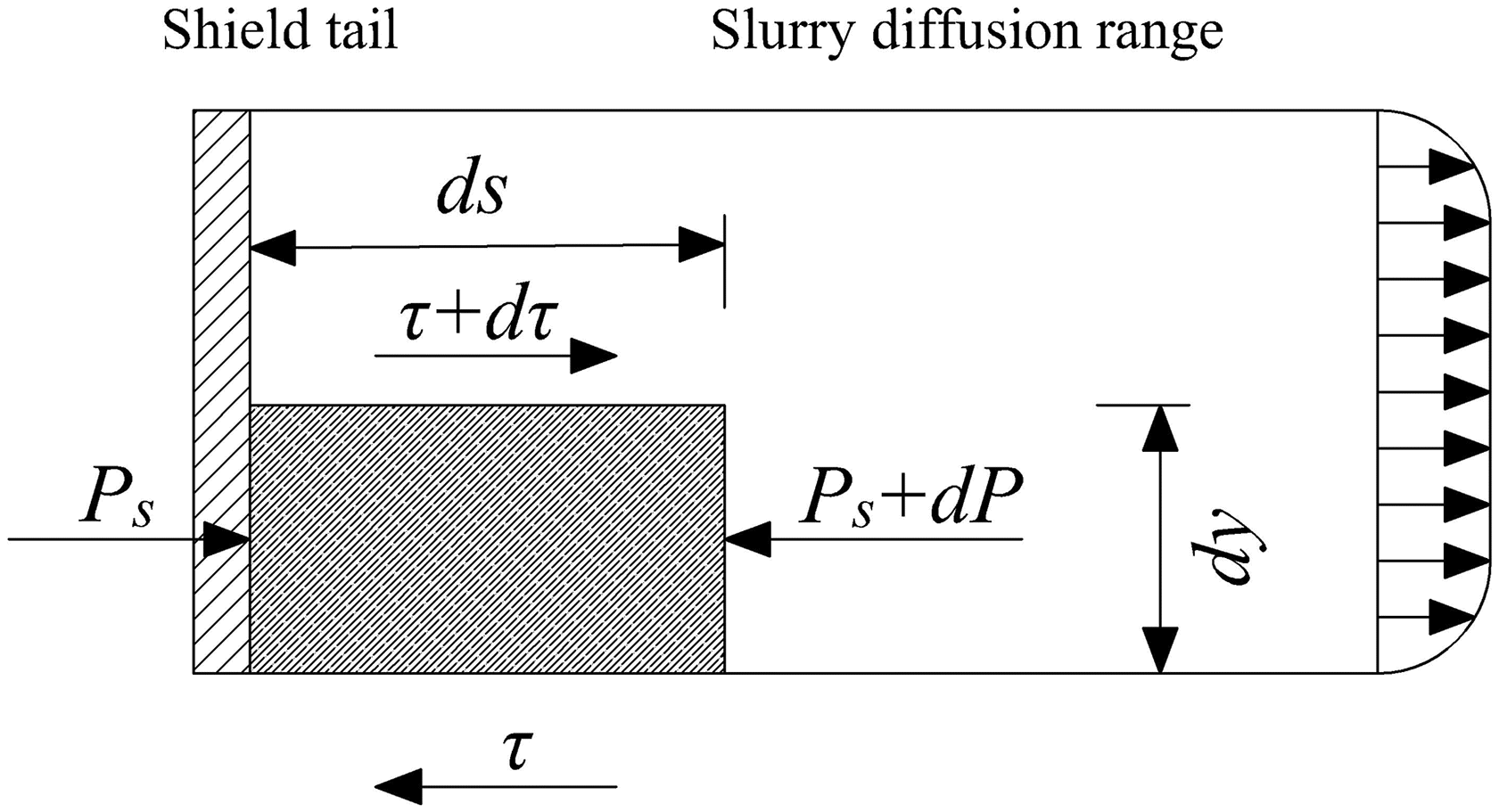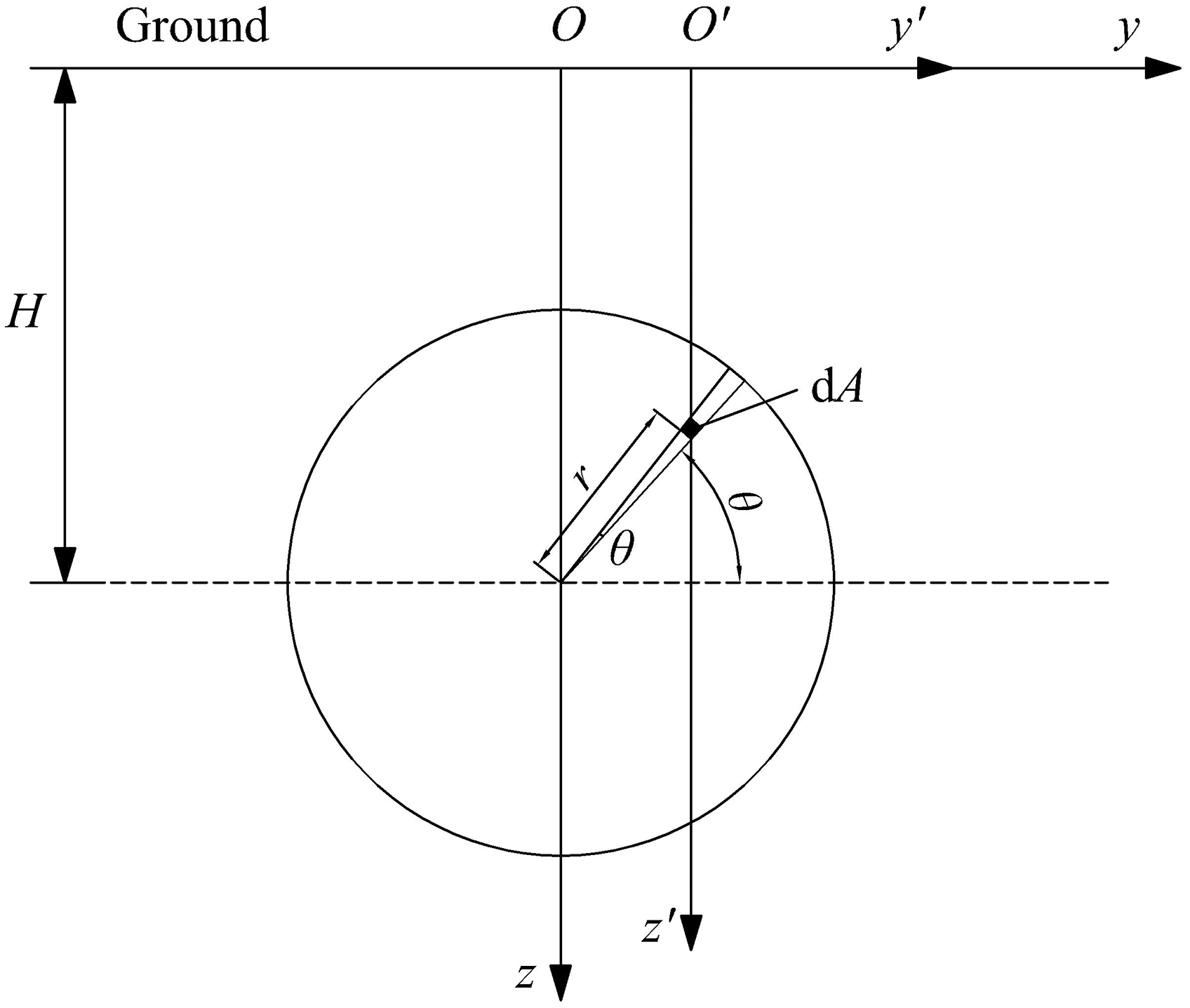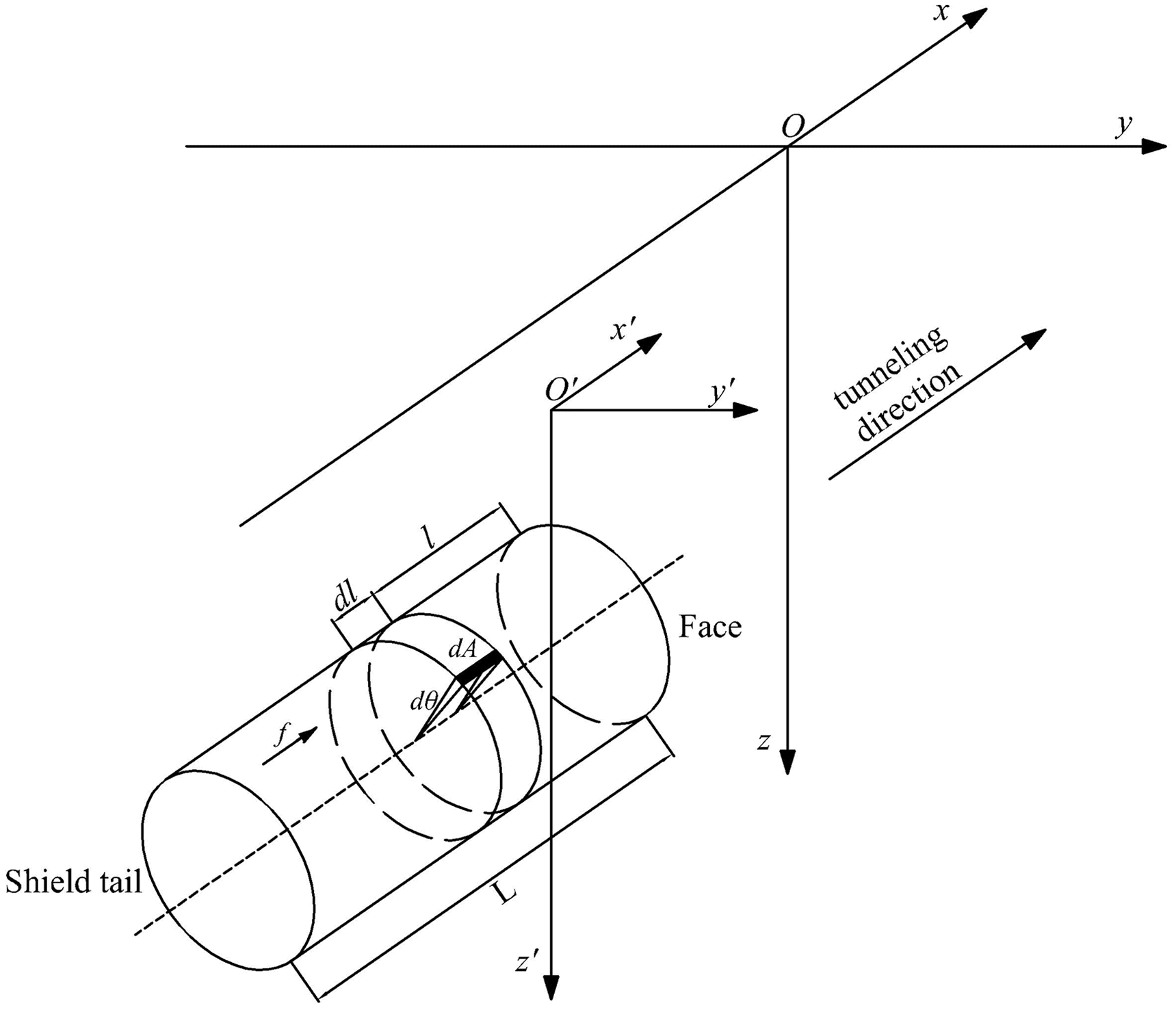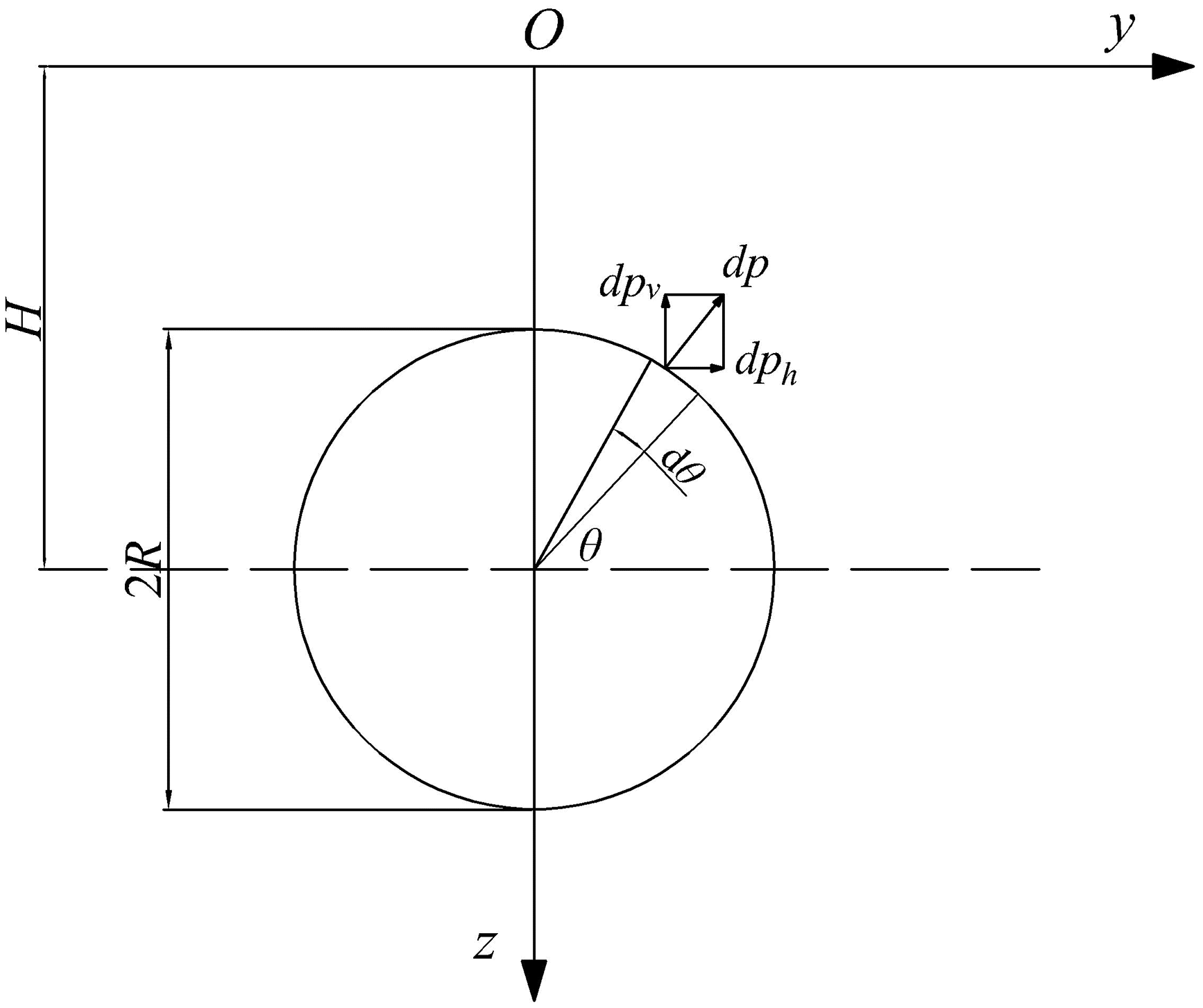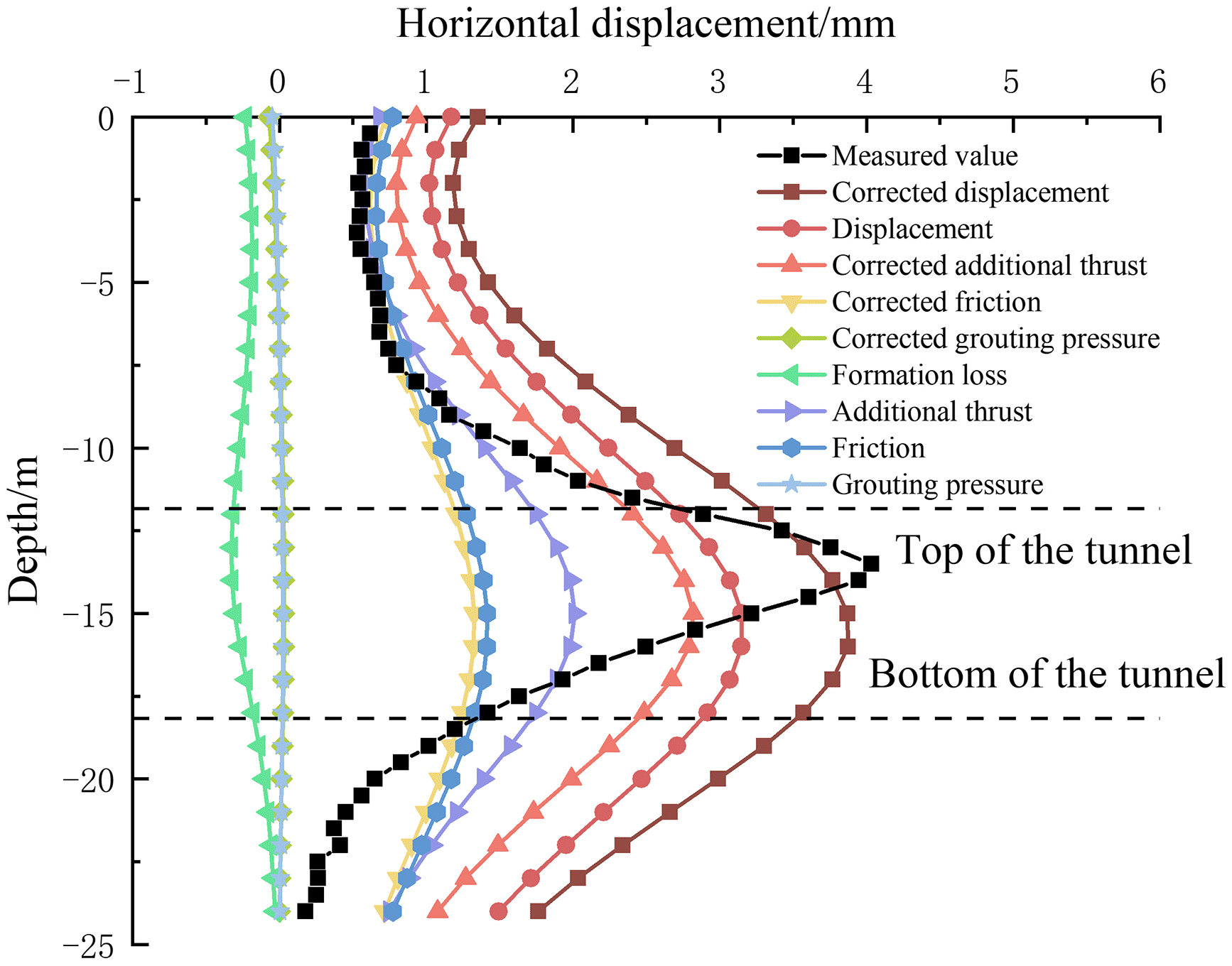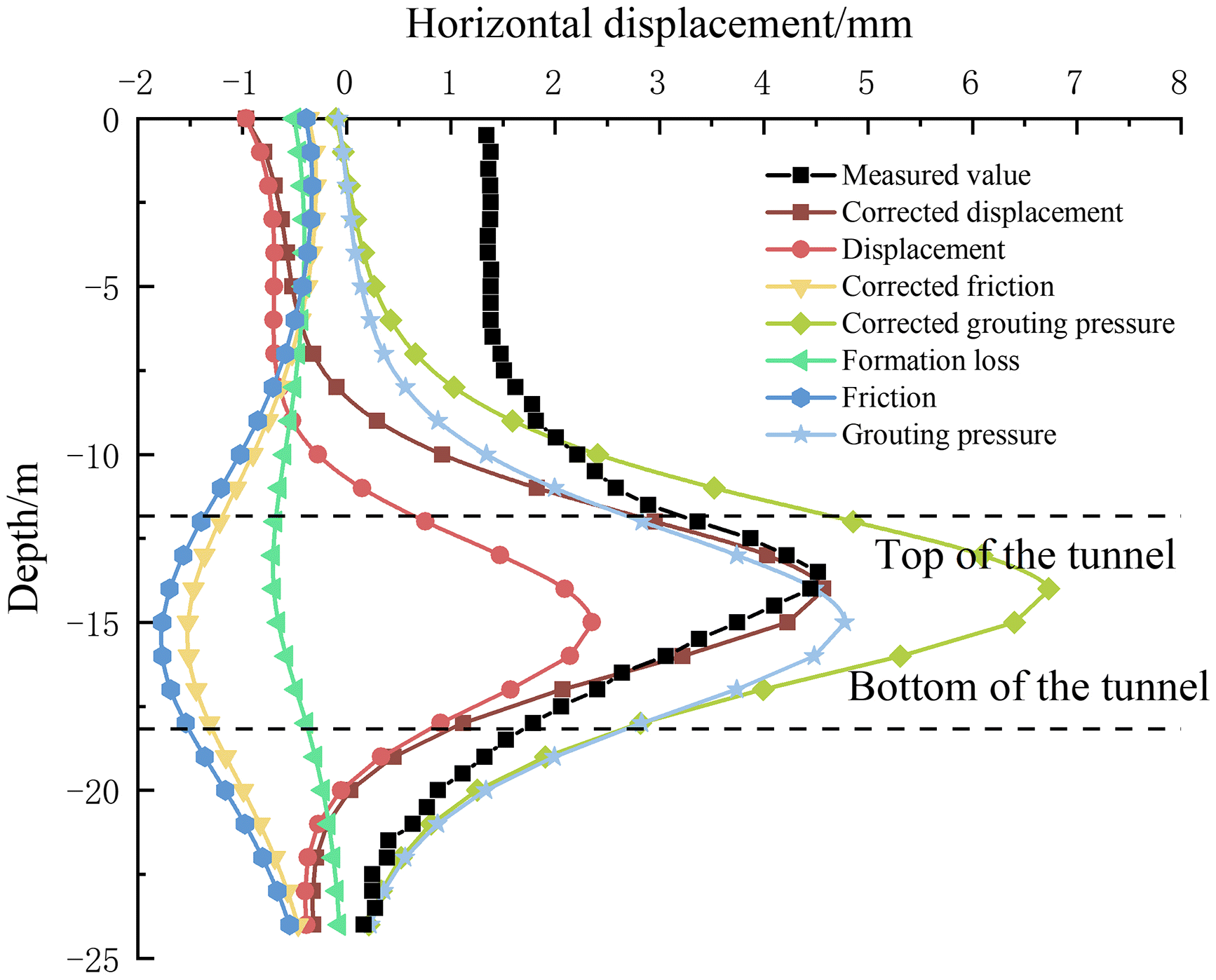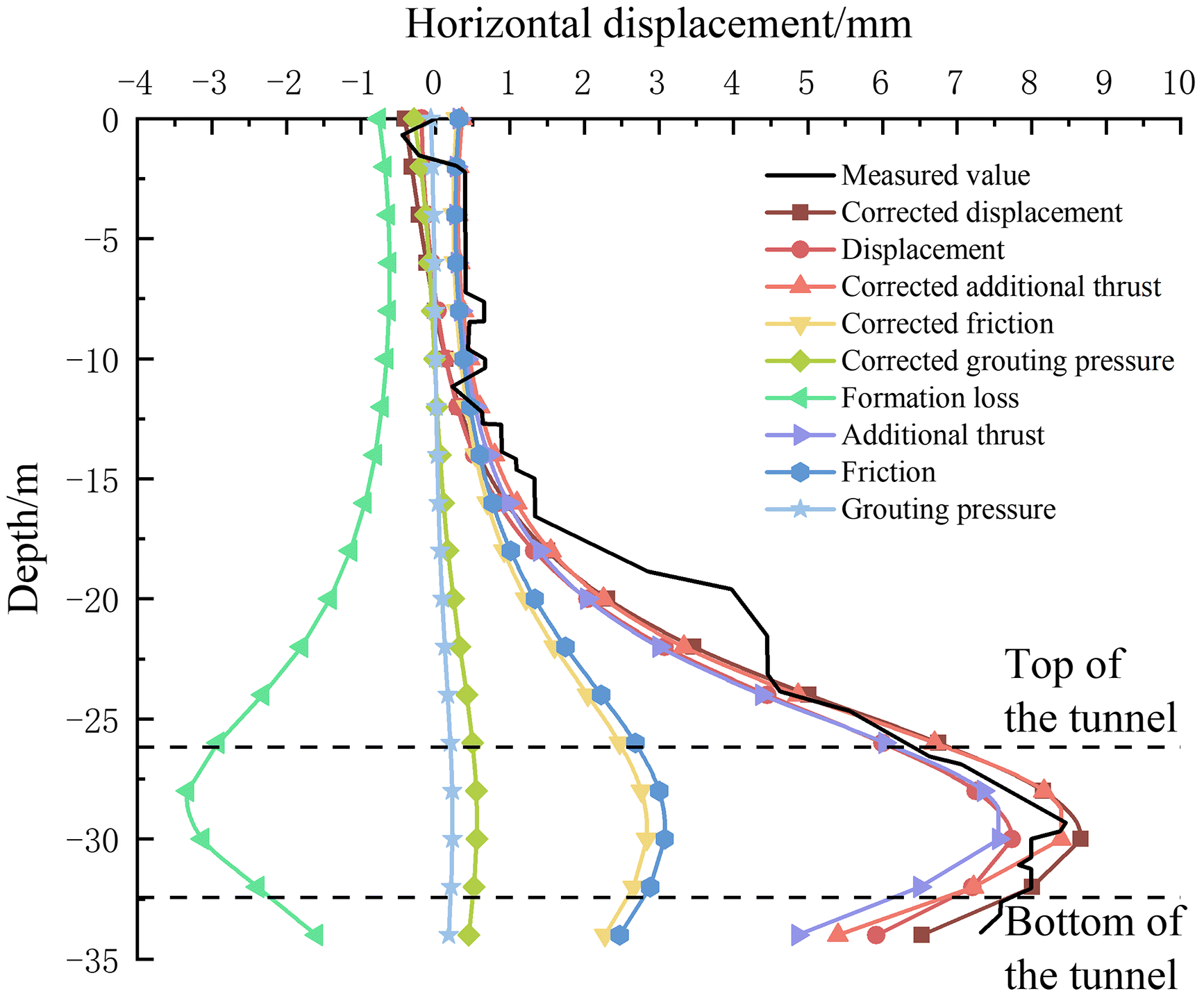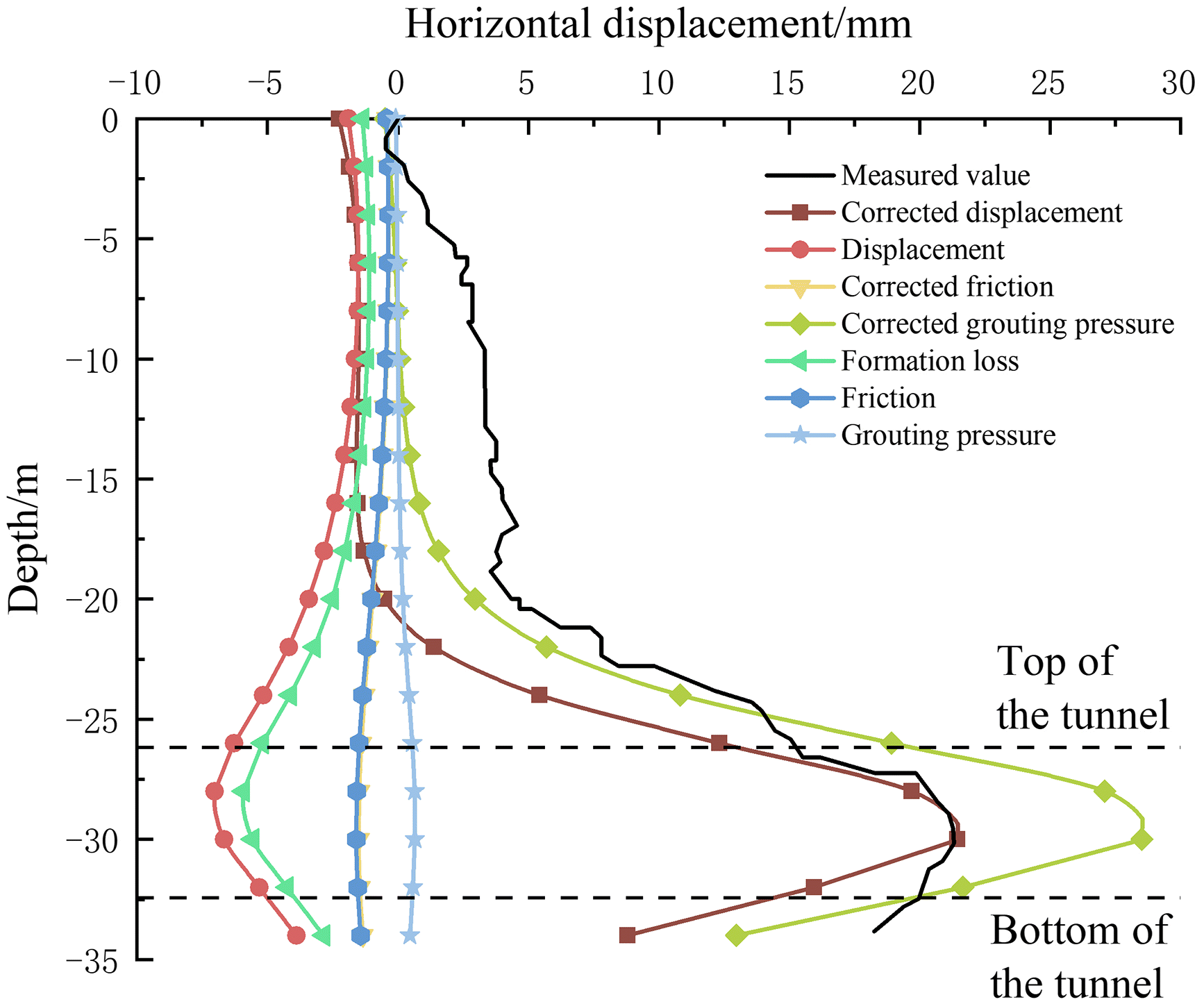2.2. Additional thrust distribution considering formation lateral pressure
In shield tunneling, there must be a pressure difference between the support pressure applied to the excavation face and the earth and water pressure of the stratum, that is, the shield frontal additional thrust. At present, when many studies analyze the influence of the frontal thrust of shield machine, for earth pressure balance (EPB) shield and slurry shield, the pressure value at the center of the cutter at the excavation face is generally selected for the study, and it is assumed that the cutter frontal thrust and slurry pressure are uniformly distributed on the excavation face, or the additional frontal thrust is simply assumed to be 20 kPa (
Deng et al. 2022 ;
Jia and Gao 2022;
Mei et al. 2022). However, when the diameter of the shield machine is small, it can be assumed that the cutter frontal thrust and slurry pressure are uniformly distributed on the excavation surface, but as the diameter of shield increases, the pressure difference of lateral ground pressure formed at the top and bottom of the excavation face cannot be ignored (
Chen et al. 2019;
Cheng et al. 2021a). To ensure the stability of the excavation surface, the frontal thrust of the cutter head and the slurry pressure applied by the large-diameter shield machine are non-uniformly distributed under the influence of the differential pressure and the self-weight of the lateral earth pressure of the stratum, and the distribution of support force of shield excavation face is shown in
Fig. 1.
To ensure the stability of the excavation surface, the frontal thrust and slurry pressure are generally greater than the lateral pressure of the formation. Therefore, the additional thrust that takes into account the uneven distribution of formation lateral pressure effects is as follows:
where
q is the additional thrust generated by the cutter head of the shield machine;
q1 is the frontal thrust of the cutter and mud pressure;
q2 is the lateral earth and water pressure;
K0 is the lateral pressure coefficient of the soil layer;
γ is the soil layer weight; and
H is the buried depth of the tunnel.
When there are no actual monitoring data, the additional thrust value can be obtained by the following methods according to Wang et al (
Jiang et al. 2018;
Wang 2009), when the EPB shield is used,
When the slurry shield is used,
where Δ
q′ is the squeezing pressure generated by the incision cut into the soil, generally taken as 10∼25kP;
μ is the Poisson’s ratio of the soil;
Eu is the undrained elastic modulus (kPa) of the soil;
v is the shield tunneling speed (cm/min);
w is the rotational speed of the cutter;
ku is the amplitude of the closed part of the cutter;
D is the diameter of the cutter (m);
ξ is the opening rate of the cutter (%);
γsl is the weight of slurry; and
ksl is the lateral pressure coefficient of slurry.
2.3. Friction distribution considering soil softening and slurry spreading
In the process of shield tunneling construction, the friction between the shield shell and the surrounding soil will cause the horizontal displacement of the soil. In most of the current researches, it is generally assumed that the friction force is uniformly distributed on the shield casing, which is inconsistent with the actual situation.
Liang et al. (2015) pointed out that the friction between the shield machine and the surrounding soil is similar to the friction characteristics of the pile–soil interface, and the surrounding soil softens during shield tunneling, and the friction is residual friction. According to the shear force formula at the pile–soil interface given by
Alonso et al. (2009), the friction force
f at any position on the shield shell can be obtained.
In the formula, βs is the ratio of residual frictional resistance to ultimate frictional resistance; σθ is the radial normal stress received at any point of the shield machine casing; δf is the interface friction angle between the casing and the soil; and σv and σh are the pressure in vertical and horizontal directions.
In previous research, it is usually assumed that the shield machine is a cylinder with a constant diameter. However, in fact, the diameter of the cutter head of the shield machine is larger than the diameter of the shield tail. This difference is very small, generally about 0.4% of the diameter of the shield machine. During the construction of the shield machine, there is a joint gap
s between the tail of the shield machine and the soil due to the difference in the diameter of the front and rear of the shield machine, as shown in
Fig. 2.
Bezuijen (2009) and
Nagel and Meschke (2011) found that the grouting slurry will spread to the joint gap of the shield tail during shield construction, and the friction force of the shield tail will be less affected by the slurry. In the calculation, the friction force at the shield tail needs to be multiplied by the reduction factor
λ. The grouting spread distance
a at any position of the shield tail can be obtained by changing the grouting pressure decay formula of the shield tail.
In the formula, Δσ is the change of grouting pressure; R′ is the radius of the shield machine and the thickness of the slurry; ΔR′ is the change of the radius; G is the shear modulus of the soil; ΔP is the change of the grouting pressure after the slurry flows; Δa is the length increment along the tunneling direction; and τ0 is the shear stress of shield tail grouting.
The calculation method is: divide the soil around the tunnel into independent areas of width Δ
a and use
eq. (6) to calculate the joint width at the tail of the shield machine. This seam width can be used in
eq. (7) to calculate the pressure change when grouting flows to the front of the shield machine at distance Δ
a. The resulting grouting pressure (original grouting pressure minus pressure change) is used to calculate changes in the next area and joint width, etc. For each calculation, it is checked whether the calculated seam width is still positive. When the joint width is 0, the soil is in contact with the shield machine, and the actual diameter of the shield machine in this area is used. For the specific calculation method of the grouting pressure at any position
θ of the shield tail, see Section 2.4.
2.4. Grouting pressure distribution considering grouting diffusion
The grouting pressure of the shield tail has an important influence on the horizontal displacement of the soil. Most of the current studies have not considered the spatial non-uniform distribution of the grouting pressure. The synchronous grouting of shield tail is divided into two independent processes: formation and dissipation. The formation of grouting pressure occurs in the stage where the shield tail and the segment are pulled out. At this stage, the grouting hole releases the slurry, and in a very short time the slurry flows along the gap between the shield tail and the segment is filled in the circumferential direction. Due to the influence of the grouting pressure distribution in the grouting hole, the slurry density, and the slurry diffusion, the circumferential grouting pressure distribution is usually a non-uniform distribution pattern with small upper and big lower. The process of grouting pressure dissipation occurs within a certain range behind the shield tail. At this time, the new grouting liquid in the circumferential direction squeezes the grouted liquid, and the extrusion effect gradually decays with the increase of the distance from the shield tail until the grouting pressure reaches a balance with the water and soil pressure of the surrounding stratum. Therefore, the grouting pressure is generated at the shield tail and decays within a certain range behind the shield tail. This is quite different from the simplified treatment of grouting pressure in most existing studies. According to the analysis of the circumferential and longitudinal filling diffusion mechanism of the slurry during the simultaneous grouting process of the shield tail, the following basic assumptions are put forward to construct the theoretical model of its circumferential and longitudinal filling diffusion:
① The slurry is an incompressible and isotropic homogeneous fluid, ignoring the loss and property change of the slurry during the diffusion process;
② After the slurry flows out of the grouting pipe, it first fills the gap in the circumferential direction and then flows in the axial direction of the tunnel in the gap of the shield tail;
③ The axial pressure of the slurry at the same point is equal to the radial pressure;
④ Since the hoop filling stage usually takes only tens of seconds to complete, therefore, regardless of the time spent in the hoop filling stage, the moment when the slurry filling is completed along the hoop is set as the start time of grouting.
1.
Circumferential distribution of grouting pressure
According to the characteristics of the grouting slurry and referring to the existing research, this paper assumes that the grouting slurry is Bingham fluid and analyzes it. The annular distribution formula of the grouting pressure P in the shield tail is
where
i is the number of the grouting hole;
Pi is the grouting pressure at the number; “±” is “+” when the slurry spreads downward, and “–” otherwise;
ρp is the density of the slurry;
g is the acceleration of gravity;
Rg is the outer diameter of the pipe; G is the angle between the grouting hole at the number and the vertical direction; and
αi is the slurry diffusion angle, when the slurry spreads upward, max
α = (
αi +
αi–1)/2 and when the slurry spreads downward, max
α = (
αi +
αi+1)/2.
In the formula, τ0 is the static shear force of the grouting slurry; μp is the plastic viscosity coefficient of the slurry; b is the gap size of the shield tail; δp is the thickness of the slurry flow pancake, δp = v t; v is the shield tunneling speed; t is the time required for the slurry to fill the gap when the shield tail is synchronously grouted, generally 30∼100 s; and qp is the interface flow, qp ≈ πRgbvm/n.
At present, 4 or 6 grouting holes are generally set for synchronous grouting of shield machine, and the applied grouting pressure is left and right symmetrical. The circumferential distribution of grouting pressure with different numbers of grouting holes is shown in
Fig. 3.
2.
Longitudinal distribution of grouting pressure
The longitudinal diffusion model of grouting slurry is shown in
Fig. 4. Taking the longitudinal slurry-micro-element as the research object, and analyzing the force of the micro-element, the force balance equation can be obtained:
Let
dPs/
ds =
B, according to the boundary conditions, at the tail of the shield,
S = 0,
Ps = P, then the pressure distribution equation of the slurry along the longitudinal direction of the tunnel is
In the formula, Ps is the longitudinal grouting pressure at the distance S from the shield tail, and it will not attenuate when the grouting pressure attenuates to equilibrium with the formation pressure; S is the distance from the shield tail, 0 < S < l; l is the grouting slurry diffusion length; B is the attenuation strength of the grouting pressure along the longitudinal direction; and τ is the shear force of the slurry.
B can be solved by Bingham’s fluid continuity equation, and the exact expression after the solution is
In the formula,
h is the filling width of the slurry;
m is the injection rate of the slurry, generally 1.1∼1.8; and
n is the number of grouting holes.
3.
Spatial distribution of grouting pressure
Combining
eq. (1) and
eq. (3), the formula for calculating the spatial distribution of grouting pressure can be obtained:
